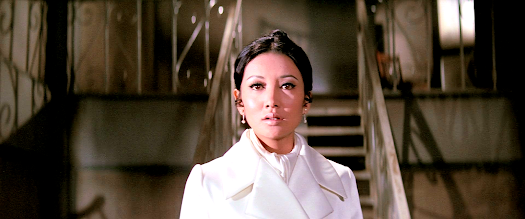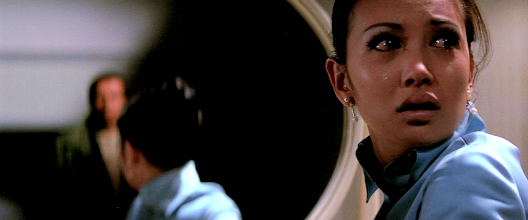 |
| Ruriko Asaoka |
Yuki (Ruriko Asaoka) is a textile designer who has studied in Europe and become a big success on her return to Japan. It probably doesn’t hurt that she looks more like a model than a designer and seems to have an inexhaustible supply of à la mode outfits. Perhaps that’s why magazine journalist Junko (Mayumi Nagisa) thinks she’d make a good subject for an article and assigns her hotshot photographer boyfriend Hibino (Etsushi Takahashi) to do the pictures.

Mayumi Nagisa

Etsushi Takahashi
However, Yuki is extremely reticent about her private life and something of a control freak, so she makes Hibino promise that they won’t use any photos she dislikes. Having a high opinion of himself, he’s a little insulted by this, but reluctantly agrees, all the time wondering why he’s been given such an assignment. He has ambitions as a serious photojournalist and has covered the conflict in Biafra, a place he intends to head back to as soon as he gets a chance. He gradually learns that Yuki is in the process of getting over a relationship with a man (whom we never see), and there also seems to be something between her and magazine boss Harada (Jiro Tamiya), but he can’t help being drawn to her despite himself…
In 1969, the star of this film, Ruriko Asaoka, had a hit single with a song entitled ‘Ai no kaseki’, which you can listen to on YouTube here. Needless to say, this film made to capitalise on that success has precious little connection with the song, other than the vague theme of yearning for a lost love. Although we don’t hear Asaoka sing it during the course of the movie, an instrumental version plays out over the opening credits and the melody recurs at various point throughout.
Director Yoshihiko Okamoto (1925-2004), who co-wrote the film with Koichi Suzuki, had a background in socially-conscious TV dramas such as Shinobu Hashimoto’s I Want to Be a Shellfish (1958), for which he had won an award (and which Hashimoto himself would remake for the cinema the following year). Ai no kaseki is the second of just three feature films by Okamoto, following Tsugaru zessho (‘Tsugaru song’, 1970) and preceding Seishun no umi (‘The Sea of Youth’, 1974). In terms of direction, it’s pretty good, and very well-shot mostly (if not entirely) on location by cinematographer Yuji Okumura, who was director Yoshishige Yoshida’s regular cameraman during this period.
The problem with Ai no kaseki is the story, which – as one might expect from a film inspired by a pop ballad – is simply too thin and not terribly interesting; it literally goes nowhere. There’s a lot of then-topical talk about Biafra, an eastern region of Nigeria which had seceded from the country in 1967, sparking a civil war which lasted two and a half years, after which it was reintegrated into Nigeria. Around one million people were said to have died as a result of the conflict, many from starvation. Perhaps Okamoto sincerely wanted to draw people’s attention to this, but, if so, having his privileged characters express their concerns about it in this type of film may not have been the best way, and, unfortunately, the issue of whether Hibino really cares about Biafra or just sees it as a means to win awards is never really explored.
In terms of the cast, Jiro Tamiya is wasted in a role which gives him little to do and Etsushi Takahashi was a limited actor better suited to action roles. Ruriko Asaoka is fine as usual, but it’s not enough to save this one – not unless seeing her in an endless parade of trendy outfits is enough for you, that is.
The film was produced by Yujiro Ishihara’s company – who had Asaoka under contract at the time – and distributed by Nikkatsu.
Amazon Japan (no English subtitles)
Thanks to A.K.





No comments:
Post a Comment